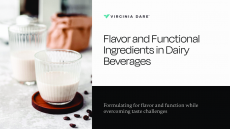Article 13 appeal in the global functional food market: Leatherhead

Leatherhead’s report – Key Players in the Global Functional Foods Industry – detailed that while globally there are lower growth rates across the functional foods market, ‘activity levels’ remain high.
The world functional food market was pegged at €19.76bn in 2011 – up 31.5% compared to 2007 – but Leatherhead noted this is based on food and drinks with specific health claims.
A true figure would be €23.5-27bn, the report said, but “if a broader definition of the market is used, including sports and energy drinks, and products offering more general health and ‘wellness’ benefits, the global market value may rise to as high as €156.25bn.”
Matthew Incles, market intelligence manager at Leatherhead, said that product development focus has been shifted to products with ‘general health claims’ under Article 13.
Better-for-you, good-for-you, fortified foods and drinks is the sector experiencing the strongest growth, Ingles told NutraIngredients.
Activity has been high “as there is a general consumer appeal for functional products” and efforts have been made in new product development (NPD), portfolio expansions and companies developing and enhancing current products, he said.
A ‘general’ appeal for consumers
Article 13 is a ‘general function’ health claim that refers to the role of a nutrient or substance in growth, development and body functions; psychological and behavioural functions; slimming and weight control, satiety or reduction of available energy from the diet. These claims do not include those related to child development or health or disease risk reduction.
“We have seen an uplift in products carrying associated health claims with EFSA’s Article 13 approval which has been stifling investment in health products,” he said.
Companies are starting to assess whether the time and money spend on products with a validated health claim are worth the return on investment, or if it is possible to communicate the message in a different way – with a softer positioning, Incles detailed.
“The wonder-tonic positioning and products with measurable benefits and very stand-out claims are starting to wear out a little,” he added.
There have been high NPD levels in using caffeine and oats and wholegrain, he said, especially in developed economies where satiety is a core focus.
Ageing opportunities
Across the market there has been increased investment in caffeine variations too in energy drinks and a shift in efforts towards bone health with calcium and Vitamin D fortified drinks and breakfast goods.
However, he identified the ageing consumer group as holding “under-exploited opportunities”.
“There have been major population changes across the globe with an increase in ageing consumers and this area has not been fully addressed by food and beverage companies,” Incles said.
Cognitive performance product development is an area of opportunity, such as goods fortified with essential fatty acids like omega-3 and omega-6.
“NPD in the functional food market has seen year-on-year growth but products targeted at seniors remains in its infancy at the moment,” he said, and there is a “fairly evident trend of a larger ageing population looking for health products.”
A dip in functional foods
This re-focus towards general health claims and strong competition from food and beverage companies positioned on a more general wellness platform explains the dip in the functional food market, Incles said.
However consumer fatigue and the increasingly complex regulatory environment outlined by EFSA, has also dampened growth rates, as well as increasingly price-conscious consumers sparked by the economic downturn. Western European and US markets are reaching maturity which is slowing growth, the rerport noted.
Despite this slow, the functional food market still outperforms the wider food and drink sector and there is plenty of room for growth – mainly in the developing Asian markets where consumers have an increased want to buy into the functional segment, Incles said.














